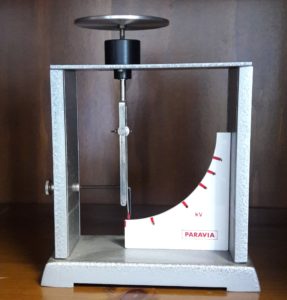
IT – Questo strumento deriva direttamente dal classico elettroscopio a foglie d’oro e fu ideato dal fisico estone Bruno Eugen Julius Kolbe alla fine del 1800, per misurare la differenza di potenziale che si genera tra il piatto superiore (su cui si pone un oggetto carico) e l’involucro dell’elettrometro stesso, collegato a terra. La parete superiore dello strumento infatti termina con un ago mobile il cui angolo di deviazione, per valori piccoli, è proporzionale al quadrato della differenza di potenziale: si possono misurare potenziali da 0,5 V fino a qualche centinaio di V .
GB – Kolbe electrometer – This instrument is derived directly from the classic gold-leaf electroscope and was designed by Estonian physicist Bruno Eugen Julius Kolbe in the late 1800s, to measure the potential difference that is generated between the upper plate (on which a charged object is placed) and the casing of the electrometer itself, connected to earth. Indeed, the upper wall of the instrument ends with a moving needle whose deviation angle, for small values, is proportional to the square of the potential difference: potentials can be measured from 0.5 V up to a few hundred V.